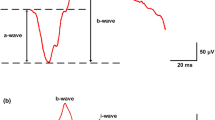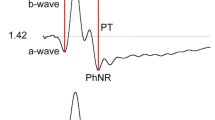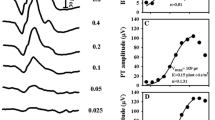Abstract
Purpose
The photopic negative response (PhNR) correlates with ganglion cell function and has previously been examined as an indicator of glaucomatous optic nerve damage. However, it is a prolonged response that is measured against baseline, and its clinical utility has been limited by extensive variability, poor repeatability, and baseline instability. We have observed a distinct brief negative wave (“N-wave”) commonly present within the slow PhNR trough, which may provide practical and analytic advantages as a clinical measure.
Methods
We reviewed data from an interventional trial of 59 glaucoma patients who had 4 exams over an 8-month period. The PhNR was recorded with standard ISCEV stimuli (1 Hz and in some cases 4 Hz stimulation), and N-waves were measured manually, relative to return to baseline.
Results
N-waves, when present, could be measured easily despite shifting baselines and a degree of background noise. The PhNR median amplitude centered around 18 μV, while the N-wave median centered around 7 μV, with a distribution of responses skewed toward low or zero amplitudes.
Conclusions
The N-wave appears to be a component of the longer PhNR, though its exact origin and significance remain unclear. As a rapid waveform that is independent of baseline, the N-wave is in many ways easier to measure accurately than the slower PhNR, which is highly dependent on baseline stability. The N-wave may prove useful clinically if further studies can optimize its stimulation, show its behavior in normal individuals and find correlation with markers of optic nerve disease.


Similar content being viewed by others
References
Miyake Y, Yanagida K, Kondo T (1981) Subjective scotometry and recording of local electroretinogram and visual evoked response—system with television monitor of the fundus. Jpn J Ophthalmol 25(4):438–448
Colotto A, Falsini B, Salgarello T, Iarossi G (2000) Photopic negative response of the human ERG: losses associated with glaucomatous damage. Invest Ophthalmol Vis Sci 41(8):2205–2211
Preiser D, Lagréze WA, Bach M, Poloschek CM (2013) Photopic negative response versus pattern electroretinogram in early glaucoma. Invest Ophthalmol Vis Sci 54(2):1182–1191
Viswanathan S, Frishman LJ, Robson JG, Walters JW (2001) The photopic negative response of the flash electroretinogram in primary open angle glaucoma. Invest Ophthalmol Vis Sci 42(2):514–522
Binns AM, Mortlock KE, North RV (2011) The relationship between stimulus intensity and response amplitude for the photopic negative response of the flash electroretinogram. Doc Ophthalmol 122(1):39–52
Tang J, Edwards T, Crowston JG, Sarossy M (2014) The test-retest reliability of the photopic negative response (PhNR). Transl Vis Sci Technol 3(6):1
Mortlock KE, Binns AM, Aldebasi YH, North RV (2010) Inter-subject, inter-ocular and inter-session repeatability of the photopic negative response of the electroretinogram recorded using DTL and skin electrodes. Doc Ophthalmol 121(2):123–134
Sustar M, Cvenkel B, Brecelj J (2009) The effect of broadband and monochromatic stimuli on the photopic negative response of the electroretinogram in normal subjects and in open-angle glaucoma patients. Doc Ophthalmol 118:167–177
Frishman L, Sustar M, Kremers J, McAnany JJ (2018) ISCEV extended protocol for the photopic negative response (PhNR) of the full-field electroretinogram. Doc Opthalmol 136(3):207–211
Viswanathan S, Frishman LJ, Robson JG, Harwerth RS (1999) The photopic negative response of the macaque electroretinogram: reduction by experimental glaucoma. Invest Ophthalmol Vis Sci 40(6):1124–1136
Funding
Stanford University School of Medicine, Medical Scholars Program: Brandon H Pham. Retina Research Foundation: Michael F Marmor. National Eye Institute P30-EY026877: Departmental award. Research to Prevent Blindness: Departmental award. Dompe Pharmaceuticals research grant: Jeffrey L Goldberg.
Author information
Authors and Affiliations
Corresponding author
Ethics declarations
Conflict of interest
All of the authors declare they have no conflicts of interest.
Research involving human participants and/or animals
This was a human retrospective record review, conducted in accordance with the Declaration of Helsinki. The study was approved by the Institutional Review Board at the Stanford University School of Medicine as meeting ethical standards.
Informed consent
Approved by the Stanford IRB as a retrospective, observational review of electronic medical records with waiver of consent.
Additional information
Publisher's Note
Springer Nature remains neutral with regard to jurisdictional claims in published maps and institutional affiliations.
Rights and permissions
About this article
Cite this article
Pham, B.H., Goldberg, J.L. & Marmor, M.F. The rapid N-wave as a potentially useful measure of the photopic negative response. Doc Ophthalmol 141, 253–257 (2020). https://doi.org/10.1007/s10633-020-09769-w
Received:
Accepted:
Published:
Issue Date:
DOI: https://doi.org/10.1007/s10633-020-09769-w




